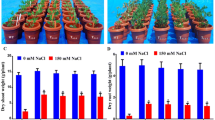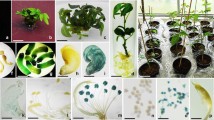Abstract
Salinity is a major abiotic stress factor limiting plant growth and productivity. One possible method to enhance plant salt-resistance is to compartmentalize sodium ions away from the cytosol. In the present work, a vacuolar Na+/H+ antiporter gene AtNHX1 from Arabidopsis thaliana, was transferred into Populus × euramericana ‘Neva’ by Agrobacterium tumefaciens in order to enhance poplar salt-resistance. The results showed that the transgenic poplar were more resistant to NaCl than the wild-type (WT) in greenhouse condition. Compared with the WT, plant growth and photosynthetic capacity of the transgenic plants were enhanced, and the transgenic plants accumulated more Na+ and K+ in roots and leaves under the same NaCl condition, whereas malondialdehyde and relative electrical conductivity were lower. All of these properties of the transgenic poplar were likely to be a consequence of the overexpression of AtNHX1 caused Na+ sequestration in the vacuoles and improved K+ absorption, thus reducing their toxic effects. These results indicated overexpression of the AtNHX1 enhanced salt-resistance of poplar, and AtNHX1 played an important role in the compartmentation of Na+ into the vacuoles. Therefore, this study provides an effective way for improving salt resistance in trees.






Similar content being viewed by others
Abbreviations
- AtNHX1 :
-
Tonoplast-associated Na+/H+ antiporter gene of Arabidopsis
- C a :
-
Atmospheric CO2 concentration
- C i :
-
Intercellular CO2 concentration
- DW:
-
Dry weight
- F v/F m :
-
Maximum photochemical efficiency of PSII
- G s :
-
Stomatal conductance
- MDA:
-
Malondialdehyde
- nptII :
-
Neomycin phosphotransferase II gene
- P n :
-
Net photosynthetic rate
- REC:
-
Relative electrical conductivity
- RT-PCR:
-
Reverse transcription
- TR:
-
Transgenic poplar
- WT:
-
Wild-type poplar
References
Adams P, Thomas JC, Vernon DM, Bohnert HJ, Jensen RG (1992) Distinct cellular and organismic responses to salt stress. Plant Cell Physiol 33:1215–1223
Apse MP, Aharon GS, Snedden WA, Blumwald E (1999) Salt tolerance conferred by overexpression of a vacuolar Na+/H+ antiport in Arabidopsis. Science 285:1256–1258
Arnon DI (1949) Copper enzymes in isolated chloroplasts. Polyphenoloxidase in Beta vulgris. Plant Physiol 24:1–15
Bayuelo-Jiménez JS, Debouck DG, Lynch JP (2003) Growth, gas exchange, water relations, and ion composition of Phaseolus species grown under saline conditions. Field Crop Res 80:207–222
Belkhodja R, Morales F, Abadía A, Gómez-Aparisi J, Abadía J (1994) Chlorophyll fluorescence as a possible tool for salinity tolerance screening in barley (Hordeum vulgare L.). Plant Physiol 104:667–673
Bradshaw HD Jr, Ceulemans R, Davis J, Stettler R (2000) Emerging model systems in plant biology: poplar (Populus) as a model forest tree. J Plant Growth Regul 19:306–313
Chen LH, Zhang B, Xu ZQ (2008) Salt tolerance conferred by overexpression of Arabidopsis vacuolar Na+/H+ antiporter gene AtNHX1 in common buckwheat (Fagopyrum esculentum). Transgenic Res 17:121–132
Glenn EP, Brown JJ (1999) Salt tolerance and crop potential of halophytes. Crit Rev Plant Sci 18:227–255
Greenway H, Munns R (1980) Mechanisms of salt tolerance in nonhalophytes. Annu Rev Plant Physiol 31:149–190
Hamzeh M, Dayanandan S (2004) Phylogeny of Populus (Salicaceae) based on nucleotide sequences of chloroplast TRNT-TRNF region and nuclear rDNA. Am J Bot 91:1398–1408
Hasegawa PM, Bressan RA, Zhu JK, Bohnert HJ (2000) Plant cellular and molecular responses to high salinity. Annu Rev Plant Physiol Plant Mol Biol 51:463–499
He C, Yan J, Shen G, Fu L, Holaday AS, Auld D, Blumwald E, Zhang H (2005) Expression of an Arabidopsis vacuolar sodium/proton antiporter gene in cotton improves photosynthetic performance under salt conditions and increases fiber yield in the field. Plant Cell Physiol 46:1848–1854
Hu L, Lu H, Liu QL, Chen XM, Jiang XN (2005) Overexpression of mtlD gene in transgenic Populus tomentosa improves salt tolerance through accumulation of mannitol. Tree Physiol 25:1273–1281
Imada S, Yamanaka N, Tamai S (2009) Effects of salinity on the growth, Na partitioning, and Na dynamics of a salt-tolerant tree, Populus alba L. J Arid Environ 73:245–251
Jiang XY, Leidi EO, Pardo JM (2010) How do vacuolar NHX exchangers function in plant salt tolerance? Plant Signal Behav 5:792–795
Kramer D (1983) The possible role of transfer cells in the adaptation of plants to salinity. Physiol Plant 58:549–555
Leidi EO, Barragán V, Rubio L, El-Hamdaoui RuizMT, Cubero B, Fernández JA, Bressan RA, Hasegawa PM, Quintero FJ, Pardo JM (2010) The AtNHX1 exchanger mediates potassium compartmentation in vacuoles of transgenic tomato. Plant J 61:495–506
Lutts S, Kinet JM, Bouharmont J (1996) NaCl-induced senescence in leaves of rice (Oryza sativa L.) cultivars differing in salinity resistance. Ann Bot 78:389–398
Lv S, Zhang K, Gao Q, Lian L, Song Y, Zhang J (2008) Overexpression of an H+-PPase gene from Thellungiella halophila in cotton enhances salt tolerance and improves growth and photosynthetic performance. Plant Cell Physiol 49:1150–1164
Ma HC, Fung L, Wang SS, Altman A, Hüttermann A (1997) Photosynthetic response of Populus euphratica to salt stress. Forest Ecol Manag 93:55–61
Munns R (2002) Comparative physiology of salt and water stress. Plant Cell Environ 25:239–250
Munns R, Tester M (2008) Mechanisms of salinity tolerance. Annu Rev Plant Biol 59:651–681
Murashige T, Skoog F (1962) A revised medium for rapid growth and bioassays with tobacco tissue cultures. Physiol Plant 15:473–497
Netondo GW, Onyango JC, Beck E (2004) Sorghum and salinity: II. Gas exchange and chlorophyll fluorescence of sorghum under salt stress. Crop Sci 44:806–811
Ohta M, Hayashi Y, Nakashima A, Hamada A, Tanaka A, Nakamura T, Hayakawa T (2002) Introduction of a Na+/H+ antiporter gene from Atriplex gmelini confers salt tolerance to rice. FEBS Lett 532:279–282
Peever TL, Higgins VJ (1989) Electrolyte leakage, lipoxygenase, and lipid peroxidation induced in tomato leaf tissue by specific and nonspecific elicitors from Cladosporium fulvum. Plant Physiol 90:867–875
Sambrook J, Russell DW (2001) Molecular cloning: a laboratory manual, 3rd edn. Cold Spring Harbor Laboratory Press, New York
Sibole JV, Montero E, Cabot C, Poschenrieder C, Barceló J (1998) Role of sodium in the ABA-mediated long-term growth response of bean to salt stress. Physiol Plant 104:299–305
Singh AK, Dubey RS (1995) Changes in chlorophyll a and b contents and activities of photosystems 1 and 2 in rice seedlings induced by NaCl. Photosynthetica 31:489–499
Storey R (1995) Salt tolerance, ion relations and the effect of root medium on the response of citrus to salinity. Aust J Plant Physiol 22:101–114
Sultana N, Ikeda T, Itoh R (1999) Effect of NaCl salinity on photosynthesis and dry matter accumulation in developing rice grains. Environ Exp Bot 42:211–220
Taylor G (2002) Populus: Arabidopsis for forestry. Do we need a model tree? Ann Bot 90:681–689
van Kooten O, Snel JFH (1990) The use of chlorophyll fluorescence nomenclature in plant stress physiology. Photosynth Res 25:147–150
Venema K, Quintero FJ, Pardo JM, Donaire JP (2002) The Arabidopsis Na+/H+ exchanger AtNHX1 catalyzes low affinity Na+ and K+ transport in reconstituted liposomes. J Biol Chem 277:2413–2418
Wang R, Chen S, Deng L, Fritz E, Huettermann A, Polle A (2007) Leaf photosynthesis, fluorescence response to salinity and the relevance to chloroplast salt compartmentation and anti-oxidative stress in two poplars. Trees Struct Funct 21:581–591
Wang SY, Chen QJ, Wang WL, Wang XC, Lu MZ (2005) Salt tolerance conferred by over-expression of OsNHX1 gene in Poplar 84K. Chinese Sci Bull 50:224–228
Wang YC, Qu GZ, Li HY, Wu YJ, Wang C, Liu GF, Yang CP (2010) Enhanced salt tolerance of transgenic poplar plants expressing a manganese superoxide dismutase from Tamarix androssowii. Mol Biol Rep 37:1119–1124
Yamaguchi T, Blumwald E (2005) Developing salt-tolerant crop plants: challenges and opportunities. Trends Plant Sci 10:615–620
Ye CY, Zhang HC, Chen JH, Xia XL, Yin WL (2009) Molecular characterization of putative vacuolar NHX-type Na+/H+ exchanger genes from the salt-resistant tree Populus euphratica. Physiol Plant 137:166–174
Zhang HX, Blumwald E (2001) Transgenic salt-tolerant tomato plants accumulate salt in foliage but not in fruit. Nat Biotechnol 19:765–768
Zhang HX, Hodson JN, Williams JP, Blumwald E (2001) Engineering salt-tolerant Brassica plants: characterization of yield and seed oil quality in transgenic plants with increased vacuolar sodium accumulation. Proc Natl Acad Sci USA 98:12832–12836
Zhao GQ, Ma BL, Ren CZ (2007) Growth, gas exchange, chlorophyll fluorescence, and ion content of naked oat in response to salinity. Crop Sci 47:123–131
Zheng QS, Liu L, Liu ZP, Chen JM, Zhao GM (2009) Comparison of the response of ion distribution in the tissues and cells of the succulent plants Aloe vera and Salicornia europaea to saine stress. J Plant Nutr Soil Sci 172:875–883
Zhu JK (2003) Regulation of ion homeostasis under salt stress. Curr Opin Plant Biol 6:441–445
Acknowledgments
We thank the National Key Project of Scientific and Technical Supporting Programs funded by the Ministry of Science and Technology of China (No. 2006BAD09A08-03-01) and the National High Technology Research and Development Program (863 Program) of China (No. 2007AA091702) supported the research.
Author information
Authors and Affiliations
Corresponding author
Additional information
Communicated by U. Luettge.
Rights and permissions
About this article
Cite this article
Jiang, C., Zheng, Q., Liu, Z. et al. Overexpression of Arabidopsis thaliana Na+/H+ antiporter gene enhanced salt resistance in transgenic poplar (Populus × euramericana ‘Neva’). Trees 26, 685–694 (2012). https://doi.org/10.1007/s00468-011-0635-x
Received:
Revised:
Accepted:
Published:
Issue Date:
DOI: https://doi.org/10.1007/s00468-011-0635-x




